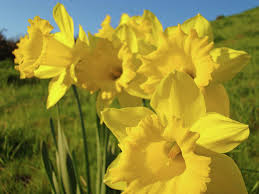
Daffodils are deer and animal resistant that will bloom for many years to come.
This makes them well worth the time and effort of planting them in your garden now.
Autumn Planting – Daffodils
A glorious bed of spring bulbs brightens your garden every year. This is well worth the time and energy you put into it now in the autumn.
Leading the pack are the showstoppers, tulips and daffodils, followed by a long list of early flowers such as crocus, snowdrops, grape hyacinth and alliums just to name a few. By planting clusters of different blubs around your garden you will enjoy a long display of flowers every spring.
Of all the beautiful spring flowering bulbs few are more dependable than daffodils. For a reliable display you can count on year after year, these popular perennials will give you ‘the big bang’ for your time and money. Once properly planted daffodils will come back for many years, blooming in early spring with very little care.
There is a long-standing debate on the correct name, narcissus, daffodils or jonquils. In this article I am simply going to use the most common name in our area, daffodils for all of them.
Trumpet shape flowers which begin to bloom in April, daffodils have a large selection of color patterns to choose from. The most popular yellow will brighten up any garden from the front door to large displays in backyards or even in open fields. In addition, pure white flowers are available as well as mixed trumpets that blend two or three colors on the same flower.
Easy to plant, place the ‘bottom’ of the bulbs six inches in the ground, 5″ to 6″ apart. They will fill in quickly. In our clay soil add a handful of chopped leaves or compost. This will lighten the soil and help with drainage. If you don’t have leaves take advantage of your neighbors who mow their leaves and put them on the street. Add some bone meal to promote strong root systems.
After daffodils have bloomed leave the green leaves until they turn yellow before cutting them back. These leaves will supply the energy for next year’s bloom. One of the few drawbacks of daffodils is that these leaves will remain until early June. When planting my summer flowering plants, I simply push the greens aside and put the new flowers between them. They quickly over grow the yellowing leaves and draw attention away from them.
One of the few yearly tasks you should do to help your daffodils remain viable is to cut off the dead flowers after they have bloomed. This will force the bulbs to transfer major energy from setting seeds into producing next year’s flowers. As a result, a healthier bulb will survive the winter.
If your flowers begin to dwindle it is time to dig up the bulbs and divide them. This chore is only required once every ten years and will increase your daffodil display.
After planting your daffodils you should water them. Watering your blubs encourages them to establish roots before the ground freezes. This will give your plants a strong head start when the ground warms up in early spring.
Autumn is also the best time to plant summer flowering bulbs such as lilies. You can find them in catalogs and garden centers. If you want to herald in the end of winter, plant snowdrops by your front door. A small simple white flower, snowdrops are one of the first to bloom in late February and early March. If they are covered by snow they become dormant and then bounce back as good as new.
Happy Autumn,
James
